As we near the end of the 2013, we enter the season when major newspapers and magazines release their “Best of [enter year] lists”. So naturally we were curious about the level of representation of authors of color in last year’s New York Times Top 10 Bestsellers list. We chose to look at their most general bestsellers list, Combined Print & E-Book Fiction (adult), and looked at the top ten books for all 52 weeks of 2012. The results were staggering, if not surprising in light of our past Diversity Gap studies of the Academy Awards, The Tony Awards, The Emmy Awards, the children’s book industry, Sci-Fi and Fantasy Films, US politics, and Silicon Valley where we analyzed yearly/multi-year samplings and found a disturbingly consistent lack of diversity. Continue reading
Tag Archives: diversity
Whitewashing Book Covers: A Trip to Barnes & Noble Part II
 Allie Jane Bruce is Children’s Librarian at the Bank Street College of Education. She
Allie Jane Bruce is Children’s Librarian at the Bank Street College of Education. She ![]() began her career as a bookseller at Politics and Prose bookstore in Washington, DC, and earned her library degree from Pratt Institute. She tweets from @alliejanebruce and blogs at Bank Street College.
began her career as a bookseller at Politics and Prose bookstore in Washington, DC, and earned her library degree from Pratt Institute. She tweets from @alliejanebruce and blogs at Bank Street College.
Part 1 | Part 2
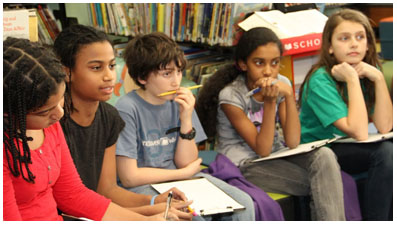
Over the course of the last academic year, I co-taught a year-long unit that allowed a sixth-grade class to explore prejudices in books and the book industry. After studying how book covers and content can marginalize groups (we studied treatments of race, ethnicity, gender, body image, sexuality, class, ability, and more), we took a field trip to Barnes & Noble—by far my favorite piece of the project. The kids exited the store with steam issuing from their ears.

Whitewashing Book Covers: What Do Kids Think? Part I
 Allie Jane Bruce is Children’s Librarian at the Bank Street College of Education. She
Allie Jane Bruce is Children’s Librarian at the Bank Street College of Education. She ![]() began her career as a bookseller at Politics and Prose bookstore in Washington, DC, and earned her library degree from Pratt Institute. She tweets from @alliejanebruce and blogs for Bank Street College.
began her career as a bookseller at Politics and Prose bookstore in Washington, DC, and earned her library degree from Pratt Institute. She tweets from @alliejanebruce and blogs for Bank Street College.
Part 1 | Part 2
In my first year as Children’s Librarian at Bank Street, I worked with two teachers on a project that allowed sixth-graders to explore implicit and explicit biases in publishing. Using book covers as a starting point for discussion, we engaged in conversations about identity, race, ethnicity, sexual orientation, gender, body image, class, and ability as they relate to books and beyond.
Exciting News: Lee & Low Acquires Shen’s Books
We’ve got some exciting news to share: Lee & Low Books has acquired children’s book publisher Shen’s Books. This is a new milestone for us: we published our first book twenty years ago and are thrilled that two decades later, we continue to grow and maintain our commitment to diversity in children’s books.![]() Originally based in California, Shen’s Books was founded as a retailer in 1985 and began publishing books in 1997. Its books emphasize cultural diversity and tolerance, with a focus on introducing children to the cultures of Asia. Titles include the popular Cora Cooks Pancit, about a young girl cooking up a favorite Filipino dish with her mother, and the Cinderella series, which features retellings of the Cinderella story from cultures around the world.
Originally based in California, Shen’s Books was founded as a retailer in 1985 and began publishing books in 1997. Its books emphasize cultural diversity and tolerance, with a focus on introducing children to the cultures of Asia. Titles include the popular Cora Cooks Pancit, about a young girl cooking up a favorite Filipino dish with her mother, and the Cinderella series, which features retellings of the Cinderella story from cultures around the world.
Why Sleepy Hollow is both the Silliest and Most Important Show on TV Right Now

![]() Shana Mlawski is a native New Yorker who writes educational materials and tutors middle and high school students. She has written more than a hundred articles for the pop culture website OverthinkingIt.com, some of which have been featured in The Atlantic Monthly, The Guardian, The Huffington Post, and Ms. magazine. Her first novel, Hammer of Witches, was published by Tu Books in 2012.
Shana Mlawski is a native New Yorker who writes educational materials and tutors middle and high school students. She has written more than a hundred articles for the pop culture website OverthinkingIt.com, some of which have been featured in The Atlantic Monthly, The Guardian, The Huffington Post, and Ms. magazine. Her first novel, Hammer of Witches, was published by Tu Books in 2012.
Bring up FOX’s Sleepy Hollow and you’ll probably get one of two reactions. The first is, “OMG, guys: black people! On network television! And there’s a Hispanic guy! And John Cho! It’s almost like TV has finally entered the twenty-first century.”
The second, more common reaction goes thusly: “Wow. This show is COMPLETELY RIDICULOUS.”
Both reactions work for me. Sleepy Hollow does have an impressively diverse cast: of the eight major characters in its lineup, five are people of color (POC). More importantly, the main character is a woman of color.
As for the claim of ridiculousness… well, watch this:
[youtube=http://www.youtube.com/watch?v=IBOtvQcjnY8&w=560&h=315]
What’s most interesting to me is how the two reactions intersect. That Sleepy Hollow is racially diverse doesn’t make it unique. Want a show that isn’t all white people all the time? You can watch Scandal or Elementary. But Sleepy Hollow is something different, something rarely seen on mainstream television: a program with a non-white lead that is also a work of camp.
Camp Defined!
In her famous “Notes on Camp,” Susan Sontag defined the genre as “art that proposes itself seriously, but cannot be taken altogether seriously because it is ‘too much.’” Not a bad definition for a show that features a Headless Horseman carrying a machine gun. Sleepy Hollow takes itself seriously enough that it can quote Milton and Edmund Burke with a straight face, but its heroes also exclaim things like, “The answers are in George Washington’s Bible!” It may not be John Waters, but that sounds campy to me.
Literary Agents Discuss the Diversity Gap in Publishing
Literary agents make up a big part of the publishing machine. Most publishers no longer consider unsolicited submissions, so an agent is a must if you even want to get your foot in the door. Each year, agents review many promising manuscripts and portfolios so it is safe to say they have a good sense of who makes up the talent pool of children’s book publishing. So what kind of diversity are agents seeing? Being that the number of diverse books has not increased in the last eighteen years, in order to understand why this problem persists we decided to ask the gatekeepers.
 Adriana Domínguez is an agent at Full Circle Literary, a boutique literary agency based in San Diego and New York City, offering a unique full circle approach to literary representation. The agency’s experience in book publishing includes editorial, marketing, publicity, legal, and rights, and is used to help build authors one step at a time. Full Circle works with both veteran and debut writers and artists, and has a knack for finding and developing new and diverse talent.
Adriana Domínguez is an agent at Full Circle Literary, a boutique literary agency based in San Diego and New York City, offering a unique full circle approach to literary representation. The agency’s experience in book publishing includes editorial, marketing, publicity, legal, and rights, and is used to help build authors one step at a time. Full Circle works with both veteran and debut writers and artists, and has a knack for finding and developing new and diverse talent.

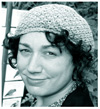 Karen Grencik and Abigail Samoun own Red Fox Literary, a boutique agency representing children’s book authors and illustrators. They offer a dazzling array of talents among their roster of clients, including New York Times and Time magazine Best Book winners, and some of the most promising up-and-coming talents working in the field today. The agency is closed to unsolicited submissions but it does accept queries from attendees at conferences where they present or through industry referrals.
Karen Grencik and Abigail Samoun own Red Fox Literary, a boutique agency representing children’s book authors and illustrators. They offer a dazzling array of talents among their roster of clients, including New York Times and Time magazine Best Book winners, and some of the most promising up-and-coming talents working in the field today. The agency is closed to unsolicited submissions but it does accept queries from attendees at conferences where they present or through industry referrals.
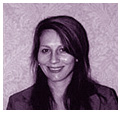 Lori Nowicki is founder of Painted Words, a literary agency that represents illustrators and authors in the children’s publishing marketplace and beyond. Their goal is to provide the utmost in representation for illustrators and writers while placing a unique emphasis on developing characters, books, and licensed properties.
Lori Nowicki is founder of Painted Words, a literary agency that represents illustrators and authors in the children’s publishing marketplace and beyond. Their goal is to provide the utmost in representation for illustrators and writers while placing a unique emphasis on developing characters, books, and licensed properties.
Do you receive many submissions from authors and illustrators of color? Overall, what percentage of authors and illustrators who submit to you are people of color? Note: Estimations are fine.
AD/Full Circle: I honestly wouldn’t know about percentages, but our agency receives a good number of submissions from authors of color. Proportionally, our agency represents more authors of color than most others. Authors and illustrators who are familiar with our work and/or visit our website know that we welcome diverse points of view, and see that diversity represented in our client list. I will say that I have personally felt for a very long time that there are simply not enough illustrators of color in the marketplace, and I am not quite sure why that is. I am usually very enthusiastic when I receive a query from a talented author/illustrator of color—I wish we received more of those! As a general rule, our agency represents illustrators who are also writers, and such people are difficult to find under any circumstances, as not everyone is equally good at both.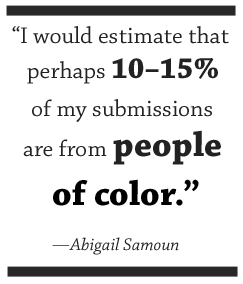
AS/Red Fox Literary: It’s hard to tell how many submissions come from authors and illustrators of color. Most of the time, I haven’t met these authors and illustrators in person so the only way for me to tell what their ethnicity might be is by their name and their choice of subjects, but these can be misleading. I once made an offer on a picture book about an African American family, told in language with a jazzy rhythm, by an author with an African American sounding name and she turned out to be a white librarian. I’d made the assumption, based on the subject and the author’s name, that she would be African American.
Oftentimes, the question of the author’s ethnicity doesn’t enter my mind—unless the subject relates to race, in which case I’ll wonder if the author will have the life experience that can provide a genuine insider’s point-of-view. I would estimate that perhaps 10–15% of my submissions are from people of color.
KG/Red Fox Literary: I have four authors of color on my list of 38 authors, but like Abi says, we never know the ethnicity of an author when they submit to us. The only way I could imagine to gauge it would be by determining how many authors of color attend an SCBWI conference at which I present, comparing that number to the total number of attendees, and then assuming the ratio of submissions to be a similar percentage. At the recent summer conference in LA, I would guesstimate that authors of color made up about 35% of the total number of attendees.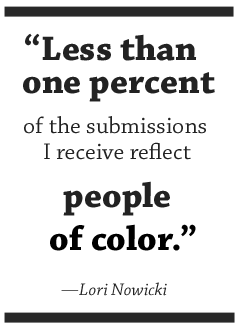
Where’s the Diversity? 5 Reasons Why the US Government Isn’t More Diverse
In our previous diversity studies on the Academy Awards, the Emmy Awards, the children’s book field, The New York Times Top 10 Bestseller List, Sci-Fi and Fantasy Films, the Tony Awards, and Silicon Valley we interviewed people who actively work in television, publishing, and the theater. We attempted to duplicate this approach for our diversity study on US politics, but with the government shutdown, none of the twelve Congresspeople we contacted responded to our efforts to reach out to them. However, we think the numbers speak for themselves: Continue reading
Trick or Treat: Diverse Books for Halloween!
Halloween, thought to have originated with the ancient Celtic festival Samhain, is just around the corner! Whether you’re planning to spend the holiday pumpkin carving, trick-or-treating, or just relaxing with a cup of steaming hot apple cider, we have six diverse books full of thrills and chills to add to your Halloween festivities!

1. Ghosts for Breakfast by Stanley Todd Terasaki, illustrated by Shelly Shinjo
In this humorous story set in the 1920s, a Japanese American boy and his father investigate their neighbors’ report of ghosts in a nearby farmer’s field.
True or False? Multicultural Books Don’t Sell
We Are the Problem, We Are the Solution
 Elizabeth Bluemle is the co-owner of the Flying Pig Bookstore in Shelburne, VT.
Elizabeth Bluemle is the co-owner of the Flying Pig Bookstore in Shelburne, VT.
As an independent bookseller, former school librarian, and lifelong avid reader, I crave the day when publishing lists are as ![]() diverse and rich as the playgrounds of our nation, and the conversation about representations of diversity in children’s literature is as unnecessary as the question of whether or not women should vote. Until that happens, there is no discussion more vital in the children’s book world than how to bring our industry at every level in line with America’s diversity.
diverse and rich as the playgrounds of our nation, and the conversation about representations of diversity in children’s literature is as unnecessary as the question of whether or not women should vote. Until that happens, there is no discussion more vital in the children’s book world than how to bring our industry at every level in line with America’s diversity.
I’ve written about this subject often over the last several years, for Publishers Weekly’s Shelftalker blog and the CCBC Diversity Committee blog, and while it seems we are, as a whole, talking a lot more about these issues within the field, and while there have been some increase in the number of mainstream children’s books featuring kids of color, we are still so far behind.
The problem is systemic and deeply rooted and requires change at every level, from the publishing houses to artists and writers to booksellers, educators, and ![[A]dults make all kinds of erroneous assumptions about what will and won’t interest children.](http://www.leeandlow.com/images/bookseller-caption1.gif) consumers. We booksellers have more opportunity to effect change than we might imagine. People entrust us with book recommendations from individual purchases to helping plan school curricula on a grand scale, and this affords us the most amazing opportunity to be aware of what we are recommending. One of the challenges inherent in selling children’s books is that we usually have to go through one or two levels of gatekeepers to reach a book’s intended audience, the child reader. We are selling to teachers and librarians, and to parents and other adult family and friends.
consumers. We booksellers have more opportunity to effect change than we might imagine. People entrust us with book recommendations from individual purchases to helping plan school curricula on a grand scale, and this affords us the most amazing opportunity to be aware of what we are recommending. One of the challenges inherent in selling children’s books is that we usually have to go through one or two levels of gatekeepers to reach a book’s intended audience, the child reader. We are selling to teachers and librarians, and to parents and other adult family and friends.
In my seventeen years as a bookseller and three years as a school librarian before that, if there’s one thing I have noticed, it’s that we adults make all kinds of erroneous assumptions about what will and won’t interest children. Time and time again, at the bookstore and at children’s book festivals, I have observed white children picking up books with kids of color on the cover, and heard adults express surprise at the choice. “Are you sure you want that one?” they’ll ask. Or, “Wouldn’t you like this book instead?” It’s not the kids who are the problem. Kids really, really, really only care about a great story. In twenty years of connecting children with books they love, I have only seen one child—ONE!—balk at a book cover because the main character was a different race from her own. It’s the adults who underestimate a child’s ability or desire to see beyond race.
How diverse is the NYPL’s 100 Great Children’s Books list?

![]() Stacy Whitman is the founder and publisher of Tu Books, an imprint of Lee & Low Books that publishes diverse fantasy, science fiction, and mystery for children and young adults. She holds a master’s degree in children’s literature from Simmons College. This post is cross-posted with permission from Stacy’s blog.
Stacy Whitman is the founder and publisher of Tu Books, an imprint of Lee & Low Books that publishes diverse fantasy, science fiction, and mystery for children and young adults. She holds a master’s degree in children’s literature from Simmons College. This post is cross-posted with permission from Stacy’s blog.
In celebration of their exhibit The ABC of It: Why Children’s Books Matter, the New York Public Library has released a list of 100 great children’s books from the last 100 years. I’m pretty happy to see that 27 of the 100 titles are diverse (in humanity) titles, and that there’s even more diversity in the authors (Donald Crews’s Freight Train, for example, doesn’t feature human diversity in the text, because the main character is a train, but the author is African American). How many of them have you read?

